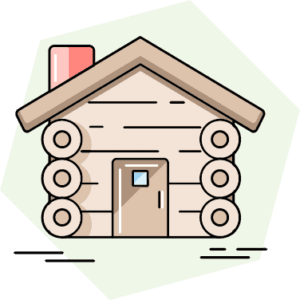When you shop for homeowners insurance, it is important to know what factors play a role in the cost of the policy. Each insurance company may vary slightly on what factors determine an insurance premium, but most insurers will factor in the age of your home and the construction materials used.
Looking for a newer home and one built with favorable materials may lead to a lower insurance premium. Other factors that play a role in the insurance premium include the following:
- Location
- Size of the home
- Safety features
- Possible risks, such as pets or a pool
- Credit score and claim history
Table of Contents
The Impact of Home Age on Insurance
One of the most influential factors on premiums is the age of the home being insured. The older the house, the more expensive it may be to insure. An older home may have outdated wiring, faulty plumbing, or a leaky roof. All of these can lead to a possible insurance claim.
In addition, building codes have evolved, making new homes safer. Older homes may need to be updated to today’s building standards before an insurance company will insure them.
Wear and Tear Over Time

Over time, a home is susceptible to wear and tear caused by the environment and aging. This can include leaky plumbing, outdated electrical, or worn-down roofing. Although the homeowner did not cause this damage on purpose, the issues can still cause massive damage if left unattended.
Outdated wiring or plumbing can lead to water damage or electrical fires. An old, worn-down roof can lead to missing shingles or water leakage.
The older the home, the more likely that there is wear and tear to the house. Updating significant features of the home, such as the plumbing, can help with the home’s insurability. With some insurance companies, updating your home’s systems may lead to a reduction in premiums.
Historic Homes
A historic home must be maintained to preserve the historic value and character of the home. The home must meet the criteria set forth by the local landmark association. Usually, the criteria includes the following:
- The home’s age
- The home being in the same form and character as when it became historical
- The home being associated with a historical event or person
These homes may cost more to insure because they are usually bigger, more extravagant homes, and they must maintain their original form and character. For example, if a historic home is made with wooden columns and they are damaged in a fire, the insurance company would need to replace the columns with the same type of columns to meet the historic home guidelines.
How Construction Materials Influence Premiums
On the market today, there are homes made of many different types of materials. With such a variety, it is important to know how insurance companies view each type of home and how the insurance premium is affected.
Wooden Structures

A wooden structure home, such as a log or timber frame home, may be more expensive to insure. These types of homes are more vulnerable to damage caused by rot, insects, and fire than some other types of homes. Wooden structures may also be more expensive to build in the event of a total loss. This may also raise the premium of your insurance policy.
Bricks and Masonry
Brick and masonry-type homes tend to have lower insurance premiums overall. These homes are made of solid, durable brick, concrete, or stone materials. For this reason, they hold up well against deterioration and weather. These materials stand up well against fires and other perils.
Steel and Modern Composites
Steel and modern composite homes are made with high-strength materials such as steel and fiberglass composites. These materials are more fire-resistant and durable than other types of home materials and may come with lower insurance premiums. However, these homes may be expensive to build, as are the materials used to repair them.
How Roofing Materials Influence Premiums
The roof is another factor insurance companies look at when insuring a home. If a roof is old or leaky, the company may not insure it at all, or the insurance premium may be increased.
The type of roof the home has can also affect the insurance premium.
Traditional Shingles
Shingle roofs can last between 15-30 years, depending on the type of shingle used. Traditional shingles roofs come in several varieties, such as the following:

- Asphalt: These shingles are the basic shingles you’ve likely seen in many homes.
- Composite: These shingles are made of composite materials such as rubber and plastic.
- Architectural: Architectural shingles are the highest quality and about three times as thick as an asphalt shingle.
Traditional shingles may cost less to replace than other roofing types but usually do not offer any reduction to your home’s insurance premiums.
Metal Roofing
Metal roofing can come in various metals, such as tin, steel, or aluminum. While they are more expensive to purchase than traditional shingles, the life span of a metal roof is more than 40 years, with some lasting 60-70 years. In addition, they hold up well in weather conditions and are very durable. For that reason, a home with a metal roof may lead to a lower insurance premium.
Slate and Tile Roofs
A slate or tile roof is one of the more expensive roofing options. They are often found in higher-end and customized homes. Although they have a lifespan of 50–200 years and require little maintenance, they are expensive to replace. They also add additional weight and stress to the structure of the home.
A slate or tile roof may increase your premium due to the cost of replacing the roof. However, if it is a new roof, you may see a reduction in premium due to the safety and durability of this type of material.
The Importance of Maintenance and Upgrades
Regardless of your home type, it needs to be cared for and maintained correctly. Follow these tips for maintaining your home:

- Update your home’s major systems as needed. House components, such as the roof, plumbing, electrical, and heating, must meet building requirements. A home with outdated systems may lead to higher premiums or being uninsurable.
- Keep your home clean. Irritants such as debris, mold, and insects can cause potential damage. Doing tasks such as cleaning out your gutters and pressure washing your siding can help maintain a home’s integrity.
- Tend to issues when they arise. Waiting to fix an issue can often lead to the problem getting worse and more expensive to fix over time. Tending to problems immediately also allows you to avoid compounding issues.
Regular maintenance and upgrades can lead to a lower insurance premium. If you’re unsure how to lower your premiums (or keep them low), talk to your insurance company. They can guide you on any changes or upgrades you can make to improve your costs.
All in All
When insuring a home, insurance companies look at a variety of factors. The home’s age and the types of materials used for construction are two factors that have a significant effect on your premium. The newer the home, the better the policy price will be.
A home built with less durable materials, such as wood, can be more expensive to insure than one with more robust materials, such as steel. It is also essential to consider the age and condition of the home’s major systems. Insuring a home with older, outdated systems can lead to a higher cost for insurance.
Understanding how your home is built and why that factors into premiums can help you make the best possible decision for your insurance needs.
